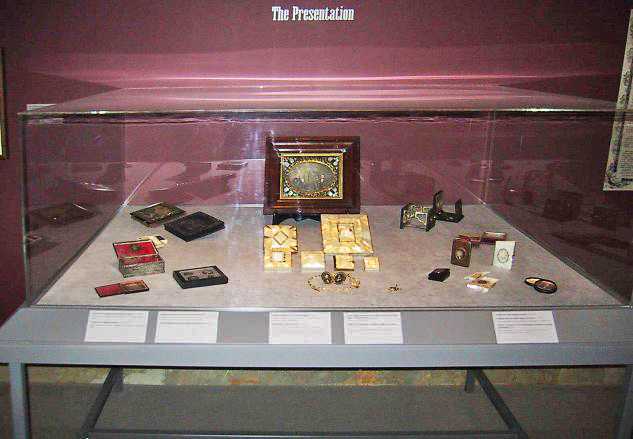

 Rare set of cases showing the full range of
standard daguerreotype sizes: the whole-, half-, quarter-, sixth-, ninth-, and
sixteenth-plate formats. Mother-of-pearl cases are rare; the whole-plate case
with cameo is one of only two known examples.
Rare set of cases showing the full range of
standard daguerreotype sizes: the whole-, half-, quarter-, sixth-, ninth-, and
sixteenth-plate formats. Mother-of-pearl cases are rare; the whole-plate case
with cameo is one of only two known examples.
 A whole-plate case by Littlefield, Parson and
Company, Florence, Mass., with a design after the famous painting by Emanuel
Leutze.
A whole-plate case by Littlefield, Parson and
Company, Florence, Mass., with a design after the famous painting by Emanuel
Leutze.
A whole-plate case, described by its manufacturer as "Papier Mache Book inlaid with pearl and painted."
 A whole-plate image in an O. G. frame, bevelled
inwards, with oval mother-of-pearl mat.
A whole-plate image in an O. G. frame, bevelled
inwards, with oval mother-of-pearl mat.
 Open silver jewelry box with red velvet lining
with sixteenth-plate daguerreotype mounted inside lid.
Open silver jewelry box with red velvet lining
with sixteenth-plate daguerreotype mounted inside lid.
Four folding lockets; three open like books, one opens on both sides.
 Daguerreotypes were trimmed with metal shears
into circles. They could then be inserted behind beveled glass into thin metal
rings for mounting in jewelry.
Daguerreotypes were trimmed with metal shears
into circles. They could then be inserted behind beveled glass into thin metal
rings for mounting in jewelry.
 These two miniature portraits (one on each
side) depict different women.
These two miniature portraits (one on each
side) depict different women.
 A mother-of-pearl case, with Baird's
Daguerreian calling card.
A mother-of-pearl case, with Baird's
Daguerreian calling card.
 Mother of Pearl cover, back and spine.
Mother of Pearl cover, back and spine.
 Inscribed inside: "This picture was taken for
Miss Almira Burrows of Providence, R.I. in 1851."
Inscribed inside: "This picture was taken for
Miss Almira Burrows of Providence, R.I. in 1851."
 Illustration of items 7 through 13 showing the
comparative size to these objects.
Illustration of items 7 through 13 showing the
comparative size to these objects.
 Sixth-plate portrait of a man inserting
daguerreotypes into lockets. On the table is an open locket awaiting its image.
Sixth-plate portrait of a man inserting
daguerreotypes into lockets. On the table is an open locket awaiting its image.
 Abraham Bogardus’s New York studio catered to
the "carriage trade." Many cased daguerreotypes were put in fancy cardboard
boxes, or—in today’s terminology—"gift wrapped." A red ribbon probably completed
the presentation.
Abraham Bogardus’s New York studio catered to
the "carriage trade." Many cased daguerreotypes were put in fancy cardboard
boxes, or—in today’s terminology—"gift wrapped." A red ribbon probably completed
the presentation.
 A vintage piece of Americana: a butterfly
hinged stereo viewing case made by John Stull of Philadelphia.
A vintage piece of Americana: a butterfly
hinged stereo viewing case made by John Stull of Philadelphia.
Case designed by S. Peck and Co., of New Haven. John Mascher of Philadelphia invented a flip-up lid stereo viewer with two eyepieces that could be placed in any daguerreian case. When the stereo craze swept America in the mid-1850s, he held a near-monopoly on the manufacture of viewers in cases.
 An original sixth-plate portrait of James Ford,
the noted San Francisco daguerreotypist, and a reversed copy of the same,
probably made about three years later. Many copy daguerreotypes were made in
this period. They are often difficult to tell from originals, unless a direct
comparison can be made.
An original sixth-plate portrait of James Ford,
the noted San Francisco daguerreotypist, and a reversed copy of the same,
probably made about three years later. Many copy daguerreotypes were made in
this period. They are often difficult to tell from originals, unless a direct
comparison can be made.